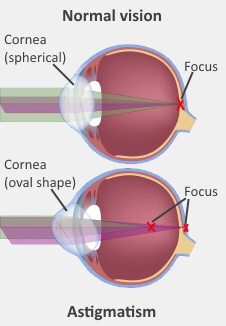Kiriwhatu pokapoka Astigmatism
About astigmatism
In a normal eye, light focuses on one spot on the light-sensitive layer at the back, called the retina. This gives sharp, clear vision. With astigmatism, the light focuses on several spots, which means you see fuzzy, blurred images.
Usually this happens because the front surface of your eye (the cornea) has an irregular or rugby-ball shape (called corneal astigmatism). Occasionally the lens inside your eye may be tilted (called lenticular astigmatism). Whatever form of astigmatism you have, things will appear fuzzy or shadowy.

Symptoms of astigmatism
If you have astigmatism, you may notice:
- some parts of what you see are more out of focus than other parts
- reading can be uncomfortable — you may find it hard to focus
- you have frequent eyestrain symptoms, such as tired, red, or itchy eyes, or a burning sensation in your eyes
- tired eyes when trying to focus for a long time, which may cause a headache.
Diagnosing astigmatism
If you have any of the symptoms listed above, see your optometrist for an eye examination. This will show what is causing any vision problems, including astigmatism.
Treating astigmatism
The treatment for astigmatism adjusts your focus precisely onto your retina, so you can see sharp images instead of fuzzy ones.
Corrective lenses (glasses or contact lenses) change the way light focuses into your eye, and refractive surgery (laser surgery) reshapes the surface of your eye so light focuses onto your retina.
Glasses
Prescription glasses can correct both corneal astigmatism (when your cornea is an irregular shape) and lenticular astigmatism (when the lens inside your eye is tilted). Depending on how serious your astigmatism is, you may need to wear them all the time, or you may only need to wear them when you are concentrating on a specific task.
It can take a while to get used to glasses for astigmatism because as well as making your vision sharper, the glasses may slightly distort your vision for a few days. For example, a round plate might look oval or a flat table might seem bowed. Most people get used to this quickly, but some people need to have their prescription changed slightly. Your optometrist will talk with you about this when deciding which treatment option suits you best.
Contact lenses
There are many different types of contact lenses available, in both hard (rigid, gas permeable) and soft (usually disposable) materials. They include options for extended-wear prescriptions. Ask your optometrist which ones will be best for you.
Refractive surgery
Refractive surgery can permanently reshape the surface of your eye, using methods such as LASIK, PRK and LASEK. Ask your optometrist for more information. They can assess if you are suitable for surgery and refer you to a specialist eye surgeon if appropriate.
Clinical review
This content was written by HealthInfo clinical advisers. It has been adapted for Health Information and Services.